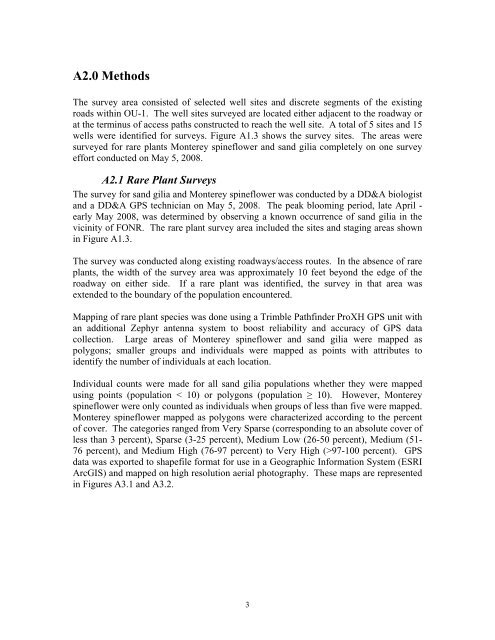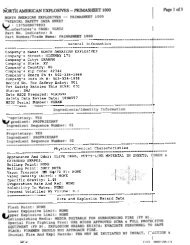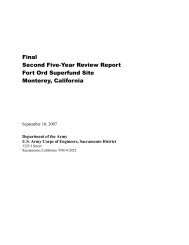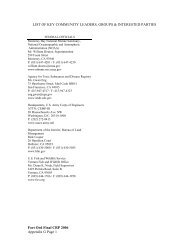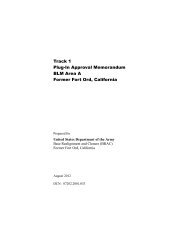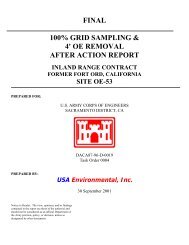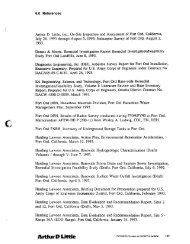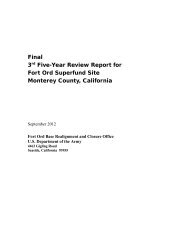APPENDIX A 2008 RARE PLANT AND HABITAT SURVEY RESULTS
APPENDIX A 2008 RARE PLANT AND HABITAT SURVEY RESULTS
APPENDIX A 2008 RARE PLANT AND HABITAT SURVEY RESULTS
You also want an ePaper? Increase the reach of your titles
YUMPU automatically turns print PDFs into web optimized ePapers that Google loves.
A2.0 Methods<br />
The survey area consisted of selected well sites and discrete segments of the existing<br />
roads within OU-1. The well sites surveyed are located either adjacent to the roadway or<br />
at the terminus of access paths constructed to reach the well site. A total of 5 sites and 15<br />
wells were identified for surveys. Figure A1.3 shows the survey sites. The areas were<br />
surveyed for rare plants Monterey spineflower and sand gilia completely on one survey<br />
effort conducted on May 5, <strong>2008</strong>.<br />
A2.1 Rare Plant Surveys<br />
The survey for sand gilia and Monterey spineflower was conducted by a DD&A biologist<br />
and a DD&A GPS technician on May 5, <strong>2008</strong>. The peak blooming period, late April -<br />
early May <strong>2008</strong>, was determined by observing a known occurrence of sand gilia in the<br />
vicinity of FONR. The rare plant survey area included the sites and staging areas shown<br />
in Figure A1.3.<br />
The survey was conducted along existing roadways/access routes. In the absence of rare<br />
plants, the width of the survey area was approximately 10 feet beyond the edge of the<br />
roadway on either side. If a rare plant was identified, the survey in that area was<br />
extended to the boundary of the population encountered.<br />
Mapping of rare plant species was done using a Trimble Pathfinder ProXH GPS unit with<br />
an additional Zephyr antenna system to boost reliability and accuracy of GPS data<br />
collection. Large areas of Monterey spineflower and sand gilia were mapped as<br />
polygons; smaller groups and individuals were mapped as points with attributes to<br />
identify the number of individuals at each location.<br />
Individual counts were made for all sand gilia populations whether they were mapped<br />
using points (population < 10) or polygons (population ≥ 10). However, Monterey<br />
spineflower were only counted as individuals when groups of less than five were mapped.<br />
Monterey spineflower mapped as polygons were characterized according to the percent<br />
of cover. The categories ranged from Very Sparse (corresponding to an absolute cover of<br />
less than 3 percent), Sparse (3-25 percent), Medium Low (26-50 percent), Medium (51-<br />
76 percent), and Medium High (76-97 percent) to Very High (>97-100 percent). GPS<br />
data was exported to shapefile format for use in a Geographic Information System (ESRI<br />
ArcGIS) and mapped on high resolution aerial photography. These maps are represented<br />
in Figures A3.1 and A3.2.<br />
3


